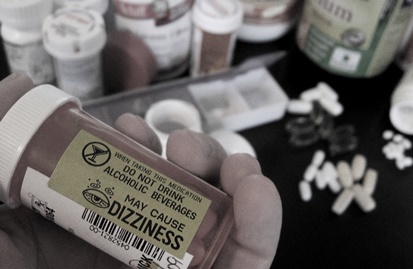
As many an old hippie might recall, the well-worn adage “Better living through chemistry” can have multiple meanings, especially in this age of miracle drugs and advanced medical cures. Whether one is a confirmed flower child from the 1960s or simply a senior citizen with a few chronic medical problems, it is important for Baby Boomers to understand that there is danger lurking for those who choose to ignore the pharmaceutical elephant in the room.

Popping pills isn’t what it used to be back in the ’60s, though the potential dangers may be just as real.
And, no, we’re not talking about those drug-induced hallucinations “enjoyed” by many enlightened souls during the Age of Aquarius, but the real and actual threat of permanent injury or death that many older people may be facing on a daily basis without even knowing it; a serious danger presented by potentially deadly drug interactions.
According to news reports, the problem of “polypharmacy” (sometimes referred to as polymedicine) has been identified as a key factor in the deaths of more than 100,000 individuals each year; however, it should be noted that the negative effects of Polypharmacy on unwitting individuals should not be confused with the beneficial application of multiple drugs (more commonly known as “combination therapy”) to fight various cancers and other serious medical conditions.
Although the benefits of multiple-drug therapies include enhanced efficacy of treatment, as well as improved safety and tolerability of pharmacotherapy, it is the unexpected or unanticipated side effects from polypharmacy that pose the greatest danger to thousands of people every month in this country.

Older patients, especially those in nursing homes or rehabilitation centers, are at particular risk due to polypharmacy.
Sadly, the most frequent victims of polypharmacy are older Boomers, other seniors, and the elderly; people who by their very age are more likely to be taking a variety of medications prescribed by their family doctor and other medical specialists; in the worst cases, the individual physicians may not be aware of all the medications prescribed by the patient’s other doctors.
For those unfamiliar with the problem, medical professionals typically use the term polypharmacy in cases where a patient is taking a regular course of five of more prescription medications. Doctors and other health experts are quick to remind the public that the actual number of medications is not as important as the possible interactions between one or more of those drugs; in fact, even non-prescription meds or certain foods can interact in an adverse manner.
While doctors are trained to understand the possible side effects that may occur when two different drugs interact, increasing the number of medications that a person is on only serves to complicate the situation. Furthermore, the threshold for dangerous reactions can actually be quite low, as many older seniors and Baby Boomers have likely already experienced.
Quite frankly, these days it doesn’t take much to push a patient above a regular intake of five different medications or supplements each day. For those lucky enough to have avoided being prescribed medication for a chronic condition until their later years, this news may come as some surprise; but as the medical community already knows, the problem of polypharmacy has been with us here in the U.S. for quite some time.
In a society that has a way of worshiping the pharmaceutical industry – at least for its ability to develop highly effective medications for many deadly diseases and other serious medical conditions – the commonly-held attitude that “more is better” can have devastating repercussions.
Unfortunately, for many people, receiving treatment from multiple doctors or medical facilities can make for a bad situation, though as we have mentioned it’s not always about quantity. When facing the addition of another medication to an already full prescription pill regimen, it’s best to consider whether or not that new drug is clinically appropriate to treat that particular condition.
Consulting with your family physician and putting all the cards on the table is likely the best first step toward avoiding some potentially deadly consequences. Although polypharmacy is hardly a new problem, statistics and medical data collected over the years indicate that it has been growing with little chance that things will just go away on their own.
In fact, the data indicates that instances of adverse drug interactions may be getting worse. According to news stories on the subject, over the past ten years the number of individuals 60 years of age and older who take five or more prescription medications exceeded 25 percent, hitting 37 percent most recently; and that number actually jumps to more than 50 percent for those aged 65 years and over.
Digging deeper, it becomes obvious that the statistics are skewed slightly toward the female segment of the population, with 57 percent of woman taking five or more drugs on a weekly basis versus 44 percent of men. This might be concerning to some Boomers and other older seniors, especially considering that studies suggest a significant number of older adults are on at least six daily medications.
For our elderly parents and other relatives, the dangers of polypharmacy can rapidly escalate when an individual enters a nursing home. According to reports, institutionalized seniors can have as many as nine or more different drugs administered regularly. In fact, a study conducted by the online pharmacy Express Scripts determined that the typical senior citizen who was seeing just two doctors had a yearly average of 276 prescription fills. As if 20-plus prescriptions fills every month was not shocking enough, more disturbing was the apparent finding that older folks run the risk of being exposed to upward of 10 medication errors every year.

Warning labels are fine for general safety, but only a qualified physician can truly know if adverse drug interactions are on the horizon for patients with multiple prescriptions.
While doctors and other medical professionals understand the risks posed by polypharmacy, it’s a fair bet that the average person is much less informed or has no real idea of the extreme dangers that can arise from mixing numerous, albeit individually useful, medications. The risks can be large and, in some instances, potentially life-threatening.
Ranging from physical or mental impairment to outright death, the side effects of polypharmacy involve what the medical community refers to as adverse drug reaction (or ADR), which even in the most benign circumstances can limit the effectiveness of one or more medications resulting in a negative impact on an individual’s other health problems.
In more severe cases, the interaction of various drugs can cause physical complications requiring the victim to be hospitalized. As Baby Boomers, we may just be hitting our stride, but the realities of multiple medical conditions experienced by older people also means that many of us may be put on more and more medications as we age.
One of the major causes of polypharmacy can come as a result of seeing more than one doctor for our various ailments. Family doctors, emergency room physicians, medical specialists and outpatient clinics are all sources of medical prescriptions. If they don’t communicate – or, more to the point, if the patient doesn’t share the latest drug information with all of them – there can be a risk.
Any person who suffers from multiple chronic conditions requiring several individual medications will likely be seeing more than one doctor. The various prescription medications, as well as any over the counter (OTC) drugs, could have an impact on his or her overall health and well-being.
Avoiding the risks of polypharmacy is something we should all consider whenever a doctor or other medical professional prescribes medication for a condition. Experts in the field offer a number of warning signs that may indicate polypharmacy or the effects thereof. These may include one or more of the following common symptoms:
- Weight loss and/or loss of appetite
- Agitation
- Insomnia and trouble sleeping
- Depression or a marked lack of interest
- Confusion
- Incontinence
- Increase in appetite or thirst
- Loss of (or reduced) ability to do one’s normal everyday tasks
Anyone who believes that they or a loved one is suffering from one or more of the above-mentioned symptoms should get in to see their doctor immediately. Because the symptoms brought on by polypharmacy can also be caused by other medical problems, it is very important to have a qualified physician examine the patient to rule out any other, potentially life-threatening conditions. Furthermore, according to experts in the field, any person who is living in a long-term care facility or transitioning from the hospital to a nursing home should be considered at greater risk of polypharmacy-related issues.

Avoiding complications from polypharmacy may be as simple as making one’s doctors and pharmacists aware of all your meds.
It is critical to understand that while Polypharmacy is a serious problem for many people, it is also preventable. Most of us have it in our control to avoid such problems, by always keeping our family doctor and other specialists aware of what each other has prescribed.
Family members who accompany older parents or relatives to the doctor would be well advised to acquaint themselves with that individual’s regular medications, so that the information can be shared at the time of an examination or other medical visit.
Whether for yourself or a loved one, it is a good idea to create an easy to read list of each and every medication being taken and share that list with the family physician, medical specialists, gerontologist – any doctor who provides treatment – not to mention one’s local pharmacist. That list should include not only prescribed meds, but also OTC drugs and dietary supplements as well. Just as important, the list should be updated as often as necessary to keep it current and to share it with one’s doctors and pharmacy professionals.



